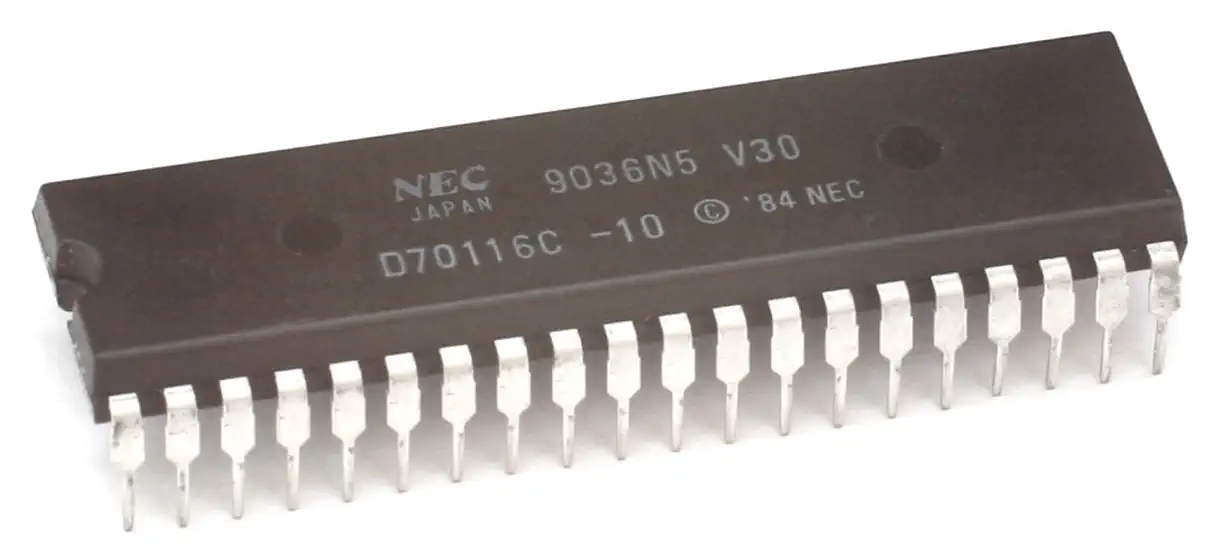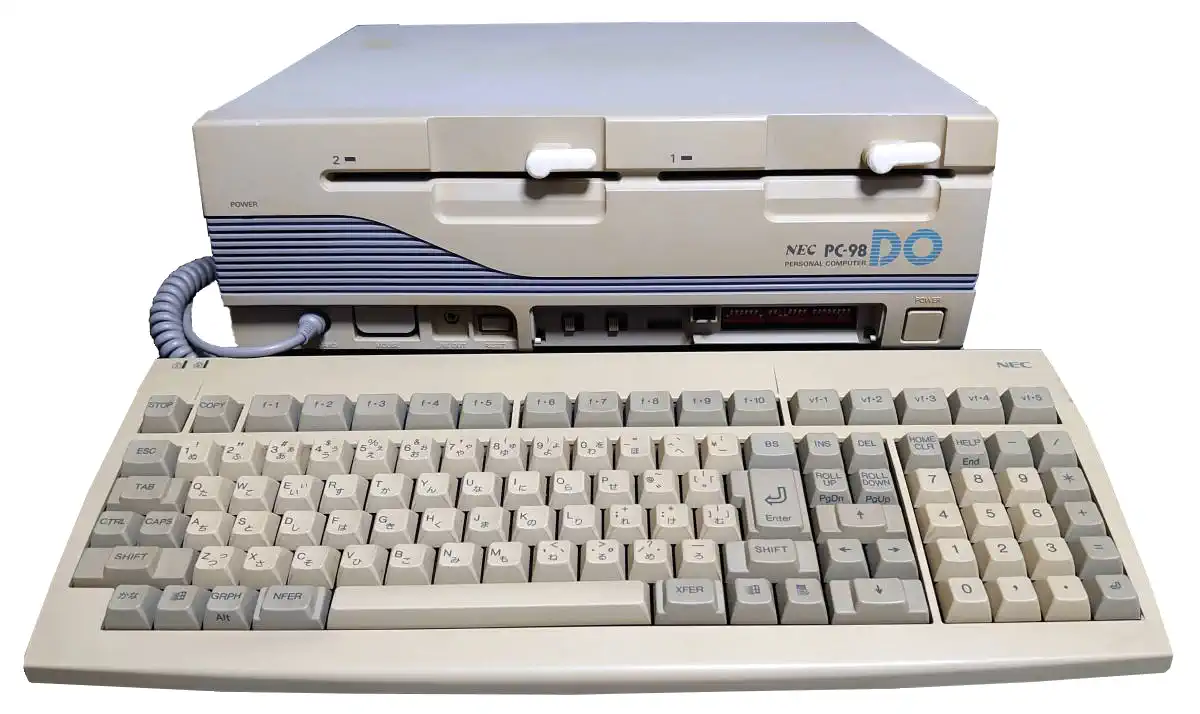NEC PC-98 DO, dual CPU computer
The Nec PC-98 DO was a dual 8-bit and 16-bit machine. The computer was equipped with both a V30 16-bit CPU running at 10MHz, as well as the Z80-compatible µPD780008 that could run at 4 or 8 MHz.
As a result the machine could run both PC-9801 and PC-8801 software. The machine uses the PC-9901 peripherals, and did not offer any backwards compatibility for PC-8801 expansion equipment.
The machine was not a huge success. Since it offered only software compatibility to the PC-8801, and had a fairly slow older processor for the PC-9801 software, it wasn't greeted with enthusiasm by either user group. The 16 bit V30 ran at 10MHz and was, compared to the full PC-98 line, much slower.
The 98 DO came with 640kByte of main RAM and 256kByte of VideoRAM. The VRAM enabled advanced graphics of 640x400 pixels using 16 out of 4096 available colors. Storage was provided by two built-in High Density (HD) floppy disk drives. As always the computer came with N88-BASIC provided in ROM. Sound was provided by the Yamaha YM2203 FM Chip that offered 3 channels of FM music.
NEC V30 CPU
The NEC V30 was a version of the NEC V20 that was pin compatible with the Intel 8086 processor. It also supports a 8080 emulation mode. The V30, running up to 10MHz, could be used as an upgrade for the 8086.
In 1984 Intel filed a lawsuit against NEC, claiming that the microcode of the V30 infringed on its patent for the 8088 and the 8086 processors. The courts ruled that microcode is protected by copyright, but that Intel had forfeited it, by neglecting to ensure that second-source chips were suitably marked. It also noted that the microcode of the V30 was not a copy of Intel's.

Yamaha YM2203 FM Sound Chip
The Yamaha YM2203 is an FM Operator Type-N (OPN) chip. It is a six channel sound chip developed by Yamaha. There are 3 FM and 3 SSG channels. The Yamaha OPN family of FM chips is used in many computer systems and video games throughout the 1980s and the 1990s. It was used in later editions of the NEC PC-8800 line of computers, some Sharp computers and many arcade game machines.
The YM2203 generates sound via frequency modulated sine waves. There are 12 different cells that each generate a 13-bit sine wave at a programmable frequency. The volume of each sine wave is controlled by a programmable ADSR envelope generator. The output of these cells can be summed by a mixer, or fed into the input of another cell creating up to 4-cell batches that create the final sound of a channel. Each channel can use 4 cells, for a total of 3 FM channels. Various combinations of ADSR parameters, multipliers and other settings make up the instrument patches, these are FM generated representations of sound that resemble certain intruments.
The SSG module of the YM2203 is basically an implementation of the YM2149 SSG chip, that was included on the YM2203. It has three wave channels and a noise generator.
A YM3014 Digital to Audio Converter (DAC) was used with the YM2203 to generate the audio signal.

Block Diagram and pin layout of the YM2203

Zilog Z80 CPU Family
The Z80 quickly became popular in the personal computer market, with many early personal computers, such as the TRS-80 and Sinclair ZX80, using the Z80 as their central processing unit (CPU). It was also widely used in home computers, such as the MSX range, SORD, and the Amstrad CPC, as well as in many arcade games. Additionally, it was also used in other applications such as industrial control systems, and embedded systems. The Z80 was widely used until the mid-1980s, when it was gradually replaced by newer microprocessors such as the Intel 80286 and the Motorola 68000.
The Z80 microprocessor was developed by Zilog, a company founded by Federico Faggin in 1974. The Z80 was released in July 1976, as a successor to the Intel 8080. It was designed to be fully compatible with the 8080, but also included new features such as an improved instruction set, more powerful interrupts, and a more sophisticated memory management system.
The Z80 quickly became popular in the personal computer market, with many early personal computers, such as the TRS-80 and Sinclair ZX80, using the Z80 as their central processing unit (CPU). It was also widely used in home computers, such as the MSX range, SORD, and the Amstrad CPC, as well as in many arcade games. Additionally, it was also used in other applications such as industrial control systems, and embedded systems. The Z80 was widely used until the mid-1980s, when it was gradually replaced by newer microprocessors such as the Intel 80286 and the Motorola 68000. The design was licensed to Synertek and Mostek as well as the European SGS.
The Z80s instruction set is binary compatible with the Intel 8080, so that 8080 code such as the CP/M Operating System and Intel's PL/M compiler for the 8080 can run unmodified on the Z80. The Z80 had many enhancements over the 8080 such as 16-bit data movement instructions, block copy and block I/O instructions, single bit addressing of all registers, IX/IY offset registers, better interrupt system and a complete duplicate register file for context switching during an interrupt.
Source: WikiPedia

VRAM: 256kB Sound Chip Yamaha YM2203 Sound Mono YM2203 FM Display Chip none Display 640x400 in 16 out of 4096 colors, text 80x25 in 8 colors Best Text 80x25 Best Color 16 out of 4096 colors Best Graphics 620x400 in 16 from 4096 colors Sprites n/a System OS N88-BASIC Storage Two 5.25 internal HD Disk Drives. Original Price ¥298,000

